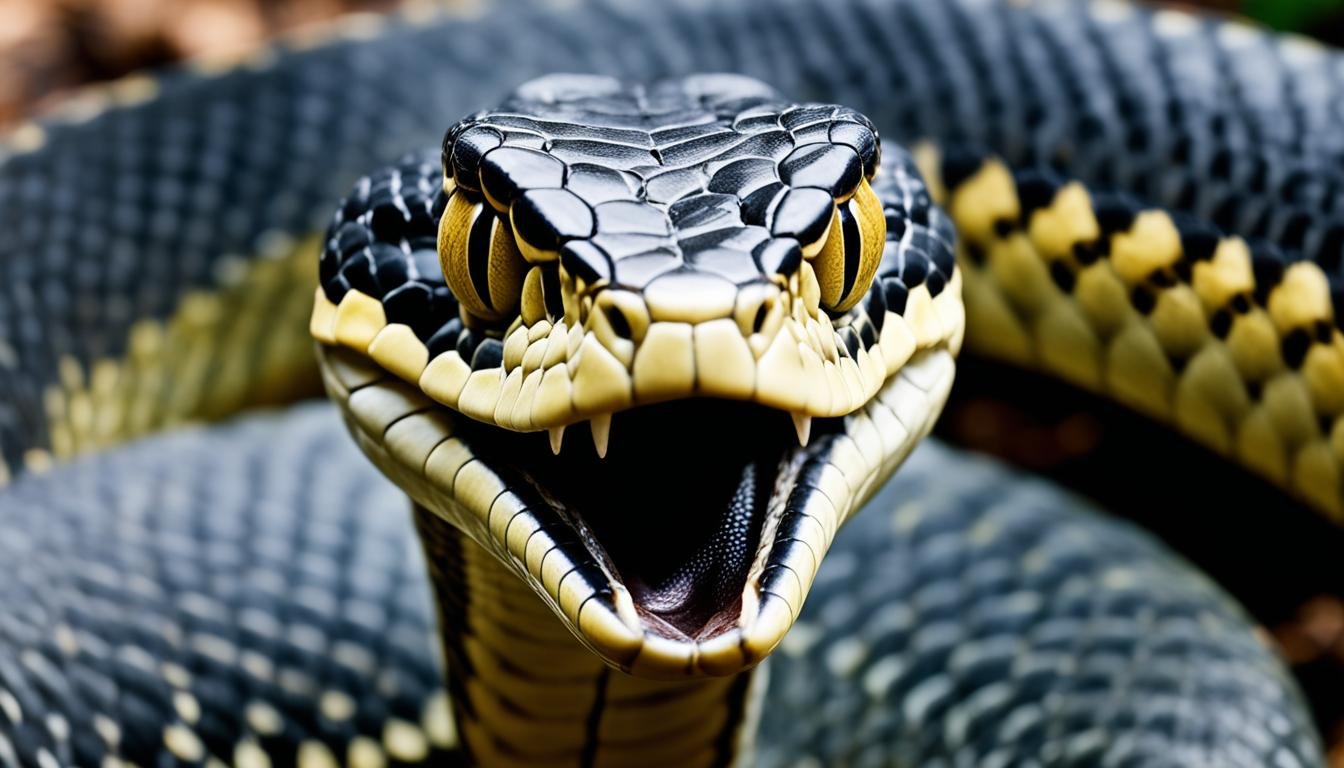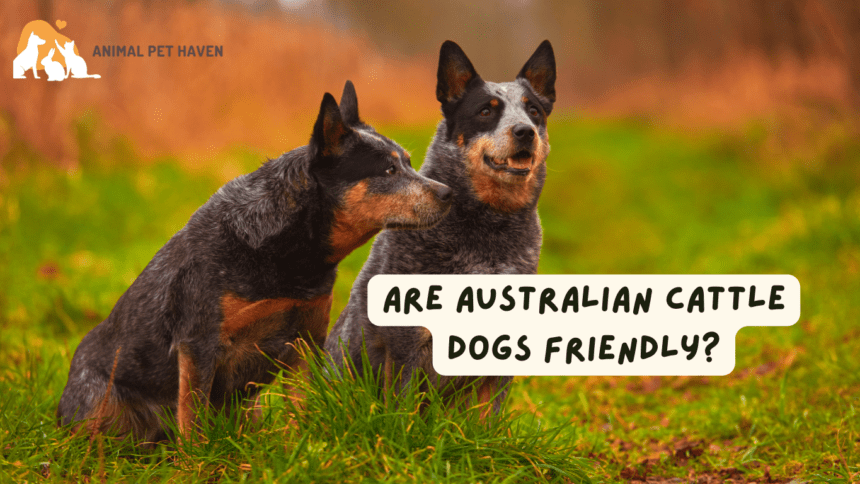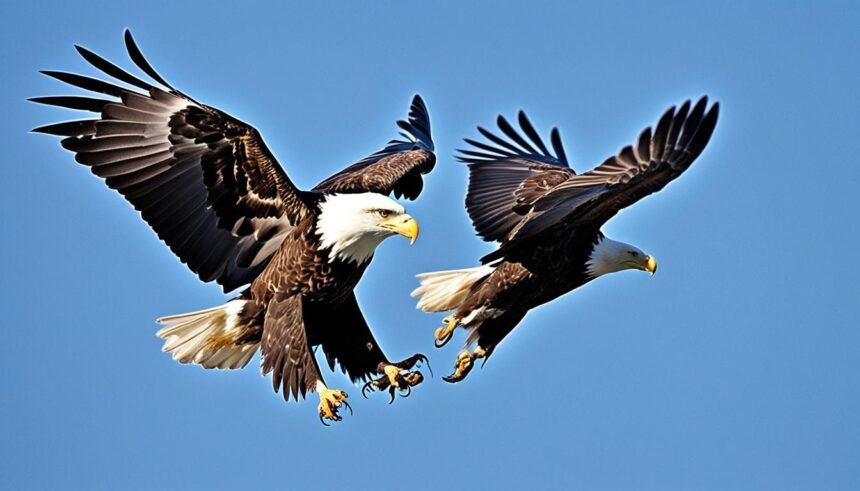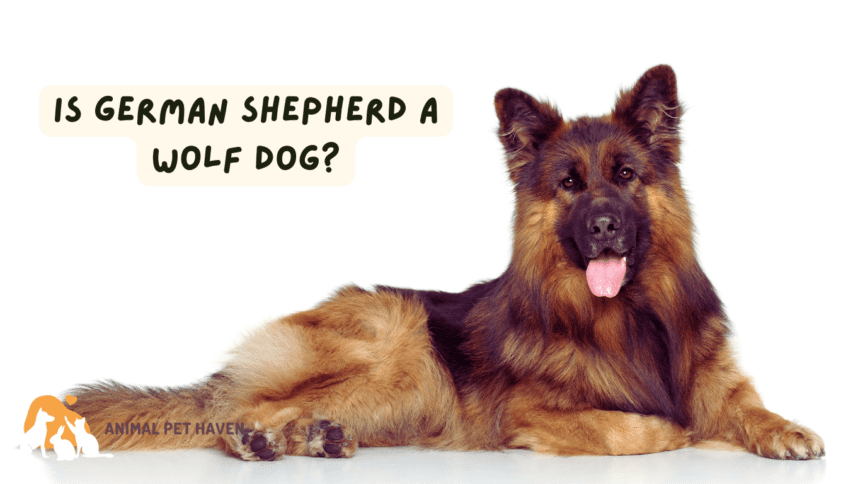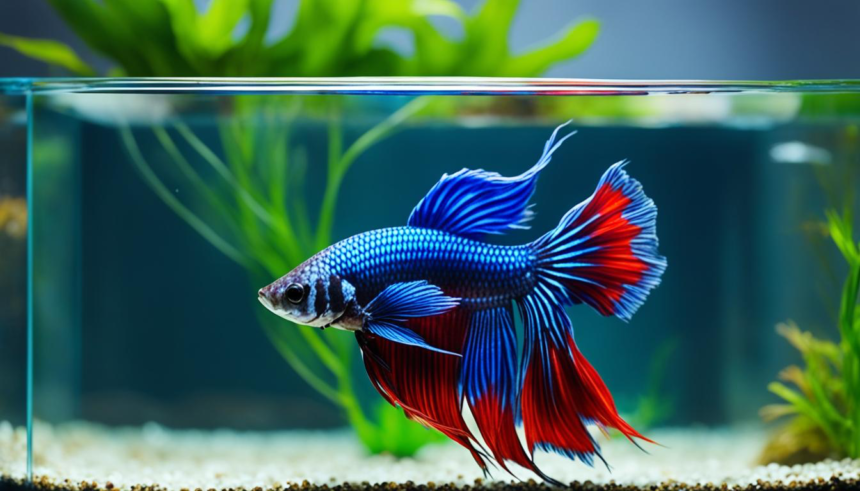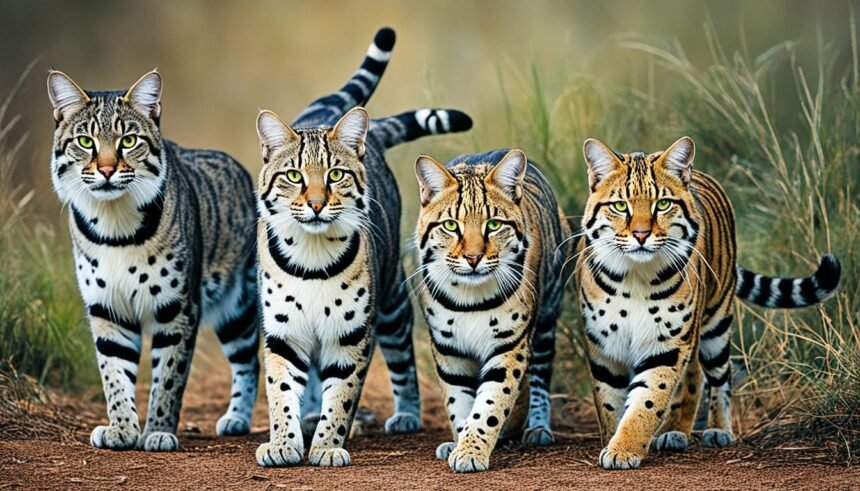You know, What is the world’s largest cobra? The king cobra is known as Ophiophagus hannah. It holds the title of the longest venomous snake in the world. It can grow up to 18 feet long, which is truly amazing in the realm of reptiles. It’s the only member of its genus, making the king cobra both incredibly interesting and a top hunter in its environment.
Typically, this venomous snake is around 10 to 13 feet long. But some are even longer. The longest ever recorded, found in Thailand, was 18 feet and 4 inches. It also weighs up to 20 pounds. This shows just how powerful it is in the animal world.
The king cobra is not just big; it’s also known for its strong venom and interesting behaviors. This piece will look into the world of the king cobra. We’ll cover its looks, where it lives, what it eats, and its challenges in the wild. Join us to learn all about this incredible snake, from how it hunts to its place in different ecosystems.
Introduction to the King Cobra
The king cobra is an exceptional snake in the Elapidae family. It’s known for its large size and unique traits. Among venomous snakes, it stands at the top.
Scientific Name and Classification
The king cobra’s scientific name is Ophiophagus hannah. It’s part of the Elapidae family, just like mambas and coral snakes. “Ophiophagus” means it eats snakes, showing a key part of its diet.
Size and Physical Characteristics
King cobras are the world’s longest venomous snakes. They can be between 10 and 12 feet long. Some can even grow to be over 18 feet. They might weigh up to 20 pounds.
Their colors range from olive green to black. They often have white or yellow bands.
Geographic Distribution
These snakes live across Southeast Asia and parts of the Indian Subcontinent. They can be found in many places, from rainforests to mountain meadows. India, southern China, and the Philippines have big king cobra populations.
King cobras are good at adapting and live in various environments.
“The king cobra is not just the longest venomous snake, but also one of the most fascinating species in the reptile world.”
| Characteristic | Description |
|---|---|
| Average Length | 10-12 feet |
| Maximum Length | Over 18 feet |
| Weight | Up to 20 pounds |
| Coloration | Olive green to black with white/yellow bands |
| Main Habitat | Rainforests to high-altitude grasslands |
What is the World’s Largest Cobra?

The king cobra is the biggest cobra and venomous snake on Earth. It can grow up to 5.6 meters (18 feet) long. But most are around 3.6 meters (12 feet) long. Males are usually larger than females. They can grow up to 3.75 meters (12.3 feet).
Among venomous snakes, the king cobra is very distinct due to its size. It has a long, thin body and a unique stripe on its neck. Even though it’s not the longest snake, it’s much bigger than other cobras.
| Species | Maximum Length | Notable Feature |
|---|---|---|
| King Cobra | 5.6 meters (18 feet) | Largest venomous snake |
| Reticulated Python | 10 meters (32.8 feet) | Longest snake overall |
| Green Anaconda | 8.43 meters (27.7 feet) | Heaviest snake |
| Indian Cobra | 1.75 meters (5.7 feet) | Common cobra species |
The king cobra is famous for being one of the biggest and most feared snakes. Its size and ability to stand up make it quite a sight in nature.
King Cobra’s Unique Features
The king cobra is truly exceptional among snakes. It has features that set it apart, making it a wondrous part of nature.
Venom Potency and Quantity
King cobras have extremely deadly venom. A single bite can deliver enough venom to kill an elephant. This venom makes them one of the most dangerous snakes on Earth.
Hood and Body Structure
The king cobra’s hood is iconic and awe-inspiring. When it feels threatened, the snake expands its neck ribs to reveal a hood covered in scales. This can grow up to 18.5 feet, making it the longest venomous snake.
Sensory Abilities
These snakes have evolved amazing senses. With their forked tongue and Jacobson’s organ, they can detect prey up to 100 meters away. They can also see well and sense vibrations, making them strong predators.
“The king cobra’s sensory abilities are so acute, it’s like they have a built-in GPS for hunting,” says Dr. Sarah Johnson, herpetologist at the National Snake Research Center.
King cobras show special behaviors during mating. Males and females may stay together for a while. Females then make nests and guard their eggs until they hatch. These snakes mature in 5-6 years and can live over 20 years in the wild.
Habitat and Ecosystem Role
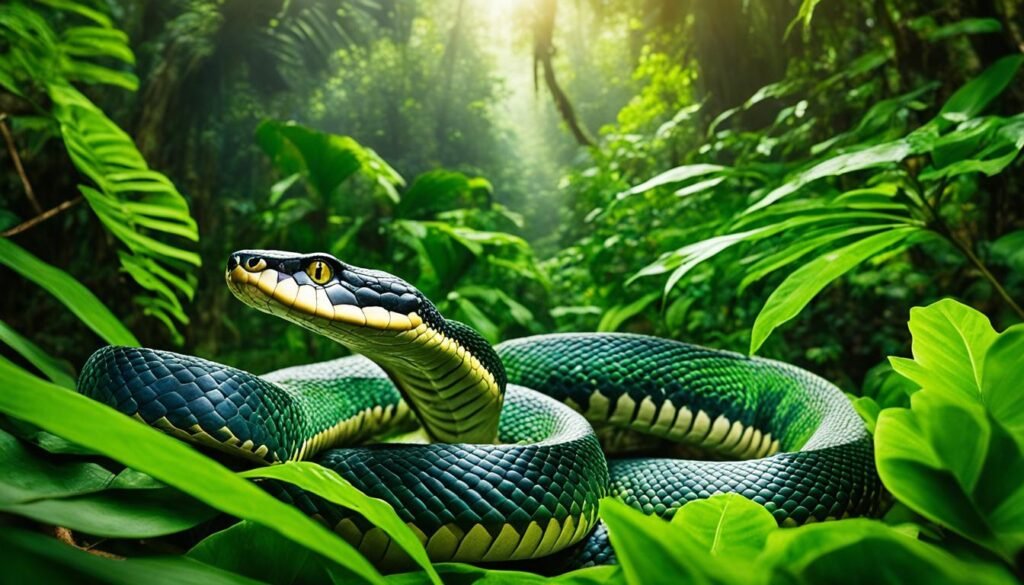
King cobras are the top snakes in their environments. They live in many places across South and Southeast Asia. These big rainforest snakes can live in jungles, bamboo areas, and swamps. They’re found from sea level up to 6,600 feet high, showing how well they can adapt.
Being the biggest venomous snakes, they help keep nature in balance. They eat other snakes and small animals. This keeps the areas they live in from getting too full. Their presence in places like mangrove swamps helps keep life there in check, which is good for the whole ecosystem.
But, these snakes are facing big problems. The cutting down of forests in Southeast Asia is taking away their homes. This pushes them closer to where people live. They are also harmed or killed by people and taken for different uses. Because of all this, they are now at risk according to the International Union for Conservation of Nature.
“The king cobra’s role as an apex predator is vital for maintaining the delicate balance of our ecosystems. We must act now to protect these magnificent creatures and their habitats.”
Many places are working to save king cobras, like Vietnam, India, and China. They are trying to keep the ecosystems in balance. Protecting the king cobras means the forests will stay healthy and diverse for the future.
Diet and Hunting Behavior
The king cobra is famous for eating snakes, showing excellent hunting skills. Its big body pairs with interesting ways to find and catch food.
Preferred Prey
King cobras mostly eat other snakes. They also catch venomous, python, and rat snakes. They eat more than snakes. Lizards, birds, and small mammals are on their menu too.
Hunting Techniques
These snakes are great at finding prey. They rely a lot on their senses like smell and feeling vibrations in the ground. After spotting a meal, a king cobra will strike accurately. Its venom quickly stops its target.
Feeding Frequency
King cobras eat slowly. They can go without food for a long time, especially after a big snake meal. This lets them do well even when food is hard to find.
| Aspect | Description |
|---|---|
| Main Diet | Other snakes (ophiophagy) |
| Secondary Prey | Lizards, birds, small mammals |
| Hunting Method | Scent and vibration detection |
| Feeding Interval | Can last months due to slow metabolism |
The king cobra stands out in its ecosystem as a top hunter. Its hunting and eating habits, along with its size and venom, give it strength in the wild.
Defensive Mechanisms and Behavior
King cobras have amazing ways to defend themselves. When they feel threatened, they do a powerful display. They lift a part of their body, showing off a scary hood. This makes them look big and scary to their enemies.
They also make a special hissing sound that’s very different from other snakes. It’s low and sounds like a growl. This sound is part of their tough image and warns others to stay away.
Although they look scary, king cobras try to stay away from people. They get tough only if they have no other choice, like when they’re trapped or protecting their eggs. This shows they’d rather run than fight humans.
| Defensive Feature | Description | Purpose |
|---|---|---|
| Raised Body | Lifts 1/3 of body off ground | Appear larger |
| Cobra Hood | Spreads neck ribs | Intimidate predators |
| Low-Pitched Hiss | Growl-like sound | Warning signal |
King cobras’ ways of defense are key for their life. They help keep dangers away without using up too much energy or venom. This saves their strength for hunting and staying alive in the wild.
Reproduction and Life Cycle
King cobras have unique ways of breeding. They perform special rituals and nest wisely. Female king cobras lead in nest building to keep their eggs safe.
Mating Rituals
During mating season, female king cobras pick more than one male to mate with. This choice lasts a while, increasing their babies’ genetic variety. After choosing her partners, the female serpent moves on to the next steps of making babies.
Nesting Behavior
Building nests is not common among snakes, but king cobras do it. The female uses leaves and scraps to build a nest. This nest safeguards her 20 to 40 eggs, sometimes even up to 60.
Incubation and Hatching
It takes 45 to 80 days for king cobra eggs to hatch. The mother king cobra protects her nest fiercely during this time. After the eggs crack, she stays a bit longer to guide her babies into the world.
For baby king cobras, early care is key to survival. They start small, just 16 to 18 inches. However, if the environment is good, they can grow to 6 feet in their first year. King cobra hatchlings take 4 to 6 years to become adults.
| Aspect | Details |
|---|---|
| Eggs per Clutch | 20-40 (up to 60) |
| Incubation Period | 45-80 days |
| Hatchling Length | 16-18 inches |
| Maturity Age | 4-6 years |
| Adult Length | 9-16 feet |
Conservation Status and Threats

The king cobra faces major challenges in the wild. Despite being a powerful snake, it struggles with dangers caused by humans. The International Union for Conservation of Nature (IUCN) calls it “Vulnerable,” which means urgent conservation efforts are needed.
Habitat loss is a huge threat to these snakes. Their homes in dense highland forests near water are disappearing fast. This is because of human actions like deforestation. It’s not only bad for king cobras but also for the environment.
The wildlife trade is also a big problem. People hunt king cobras for various reasons, like their skin and use in traditional medicine. This illegal trade is severe that in India, killing a king cobra brings up to six years in jail.
Climate change is making things worse for king cobras. It’s changing their homes and the food they find. Conservation aims to protect their habitats, stop poaching, and help people understand why these snakes are important for the Earth.
“The king cobra’s survival is crucial for biodiversity. We must act now to protect this iconic species and its habitat.”
Cultural Significance and Human Interaction
The King Cobra holds a central role in Asian snake stories. With its big size and venom, it has amazed and scared people for ages. In Hinduism, it’s like a god that protects. Images of it are in temples and old writings, showing wisdom and strength.
Role in Mythology and Folklore
King Cobras are key in Asian tales and legends. These stories often cast them as protectors of special places or riches. Their famous hood spreading has led to myths of snake gods and otherworldly figures.
Snake Charming and Captivity
Snake charming, while fun to watch, is harmful to snakes. Now, many places don’t allow it to safeguard these reptiles. Breeding the snakes in labs helps protect them, keeping their numbers up without causing harm in nature.
Conservation Efforts
Much work goes into educating the public about protecting King Cobras. Specialists bust myths and show people the snakes’ eco value. They also work hard to save places for them to live safely in nature.
| Conservation Measure | Impact |
|---|---|
| Habitat Protection | Preserves natural ecosystems |
| Captive Breeding | Maintains genetic diversity |
| Public Education | Reduces human-snake conflicts |
| Anti-Poaching Efforts | Combats illegal wildlife trade |
Conclusion
The king cobra is the largest venomous snake on Earth, showcasing the wonders of biodiversity. It can grow up to 18.8 feet long and weigh 20 pounds. Found in South and Southeast Asia, they are recognized for their hunting habits and powerful venom by those who love snake facts.
Although they are feared, king cobras are vital for nature’s balance. They eat other snakes, including the venomous ones, to keep their numbers in check. This shows their key role in keeping ecosystems healthy. Their endangered status means we must protect them and their homes.
Learning about king cobras, from their hissing sounds to how they mate, is fascinating. They’re more than just predators; they’re crucial to their environment. By respecting and understanding them, we ensure their survival for the future.
FAQ
What is the scientific name of the king cobra?
The king cobra’s scientific name is Ophiophagus hannah. It’s part of the Elapidae family.
How long can king cobras grow?
These snakes can reach up to 18 feet long. This makes them the longest venomous snake on the planet.
What is the potency of king cobra venom?
King cobras have venom strong enough to take down an elephant. They can inject up to two-tenths of a fluid ounce with a bite.
What is the geographic distribution of king cobras?
King cobras are found in South and Southeast Asia. This includes India, southern China, and the Philippines.
What habitats do king cobras prefer?
They live in a variety of places. These include rain forests, plains, bamboo thickets, and mangrove swamps. They range from sea level up to 2,000 meters.
What do king cobras primarily feed on?
King cobras mainly eat other snakes, including venomous ones. They also have lizards, eggs, and small mammals on their menu.
How do king cobras detect their prey?
They rely on sharp senses. This means they pick up on scents and vibrations with their forked tongue and Jacobson’s organ to find food.
What defensive behaviors do king cobras exhibit?
When in danger, king cobras have a strong defensive stance. They stand up to a third of their body, spread their hood, and make a low hiss or growl.
Do king cobras have unique nesting behaviors?
Female king cobras make nests for their eggs out of leaves and debris. They protect the eggs while they’re incubating. The mothers also stay with the babies for a few days after they hatch.
What is the conservation status of king cobras?
King cobras are vulnerable, according to the IUCN Red List. Their threats include habitat loss, being killed for skin and medicine, and conflict with people.

